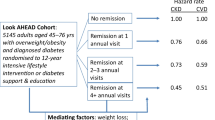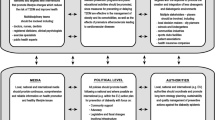Abstract
Background
The AHA has recently introduced a novel metric, Life's Essential 8, to assess cardiovascular health (CVH). Nevertheless, the association between varying levels of LE8 and the propensity for CKD is still unclear from a large prospective cohort. Our objective is to meticulously examine the relationship between LE8 and its associated susceptibilities to CKD.
Methods
A total of 251,825 participants free of CKD from the UK Biobank were included. Cardiovascular health was scored using LE8 and categorized as low, moderate, and high. Cox proportional hazard models were employed to evaluate the associations of LE8 scores with new-onset CKD. The genetic risk score for CKD was calculated by a weighted method.
Results
Over a median follow-up of 12.8 years, we meticulously documented 10,124 incident cases of CKD. Remarkably, an increased LE8 score correlated with a significant reduction of risk in new-onset CKD (high LE8 score vs. low LE8 score: HR = 0.300, 95% CI 0.270–0.330, p < 0.001; median LE8 score vs. low LE8 score: HR = 0.531, 95% CI 0.487–0.580, p < 0.001). This strong LE8–CKD association remained robust in extensive subgroup assessments and sensitivity analysis. Additionally, these noteworthy associations between LE8 scores and CKD remained unaffected by genetic predispositions to CKD.
Conclusions
An elevated degree of CVH, as delineated by the discerning metric LE8, exhibited a pronounced and statistically significant correlation with a marked reduction in the likelihood of CKD occurrence.





Similar content being viewed by others
Change history
20 March 2024
A Correction to this paper has been published: https://doi.org/10.1007/s10157-024-02473-y
Abbreviations
- AHA:
-
American Heart Association
- BMI:
-
Body mass Index
- BP:
-
Blood pressure
- CI:
-
Confidence interval
- CKD:
-
Chronic kidney disease
- CRP:
-
C-reactive protein
- CVH:
-
Cardiovascular health
- CVD:
-
Cardiovascular disease
- DASH:
-
Dietary Approaches to Stop Hypertension
- DBP:
-
Diastolic blood pressure
- eGFR:
-
Estimated glomerular filtration rate
- HbA1c:
-
Hemoglobin A1c
- HDL:
-
High-density lipoprotein
- HR:
-
Hazard ratio
- LE8:
-
Life’s Essential 8
- LDL:
-
Low-density lipoprotein
- LS7:
-
Life’s Simple 7
- Non-HDL-C:
-
Non-high-density lipoprotein cholesterol
- NSAIDS:
-
Nonsteroidal anti-inflammatory drugs
- PAF:
-
Population attributable fraction
- SBP:
-
Systolic blood pressure
References
Bikbov B, Purcell CA, Levey AS, et al. Global, regional, and national burden of chronic kidney disease, 1990–2017: a systematic analysis for the Global Burden of Disease Study 2017. Lancet. 2020;395(10225):709–33.
Elshahat S, Cockwell P, Maxwell AP. The impact of chronic kidney disease on developed countries from a health economics perspective: a systematic scoping review. PLoS One. 2020;15(3):e0230512.
Song YM, Sung J, Lee K. Genetic and environmental influences on the associations between change in kidney function and changes in cardiometabolic factors in Koreans. Clin Exp Nephrol. 2017;21(3):474–80.
Sacco RL. The new American Heart Association 2020 goal: achieving ideal cardiovascular health. J Cardiovasc Med (Hagerstown). 2011;12(4):255–7.
Rebholz CM, Anderson CA, Grams ME, et al. Relationship of the American Heart Association’s Impact Goals (Life’s Simple 7) With Risk of Chronic Kidney Disease: Results From the Atherosclerosis Risk in Communities (ARIC) Cohort Study. J Am Heart Assoc. 2016;5(4): e003192.
Lloyd-Jones DM, Allen NB, Anderson C, et al. Life’s essential 8: updating and enhancing the American Heart Association’s Construct of Cardiovascular Health: a presidential advisory from the American Heart Association. Circulation. 2022;146(5):e18–43.
Liu M, Li XC, Lu L, et al. Cardiovascular disease and its relationship with chronic kidney disease. Eur Rev Med Pharmacol Sci. 2014;18(19):2918–26.
Morales J, Handelsman Y. Cardiovascular outcomes in patients with diabetes and kidney disease: JACC review topic of the week. J Am Coll Cardiol. 2023;82(2):161–70.
Japanese Society of Nephrology. Chapter 7. CKD and CVD: cardiorenal association. Clin Exp Nephrol. 2009;13(3):205–6.
Ronco C, Haapio M, House AA, Anavekar N, Bellomo R. Cardiorenal syndrome. J Am Coll Cardiol. 2008;52(19):1527–39.
Tang R, Wang X, Li X, et al. Adherence to life’s essential 8 and incident chronic kidney disease: a prospective study of 147, 988 UK Biobank participants. Am J Clin Nutr. 2023;118(4):804–11.
Sudlow C, Gallacher J, Allen N, et al. UK biobank: an open access resource for identifying the causes of a wide range of complex diseases of middle and old age. PLoS Med. 2015;12(3): e1001779.
Collins R. What makes UK Biobank special? Lancet. 2012;379(9822):1173–4.
Petermann-Rocha F, Deo S, Celis-Morales C, et al. An Opportunity for Prevention: Associations Between the Life’s Essential 8 Score and Cardiovascular Incidence Using Prospective Data from UK Biobank. Curr Probl Cardiol. 2023;48(4): 101540.
Sun J, Li Y, Zhao M, et al. Association of the American Heart Association’s new “Life’s Essential 8” with all-cause and cardiovascular disease-specific mortality: prospective cohort study. BMC Med. 2023;21(1):116.
Li C, Chen Y, Zhao W, et al. Genetic impact on the association of sleep patterns and chronic kidney disease: a prospective cohort study of 157,175 UK Biobank participants. J Psychosom Res. 2023;169: 111323.
Kramer I, Hooning MJ, Mavaddat N, et al. Breast Cancer Polygenic Risk Score and Contralateral Breast Cancer Risk. Am J Hum Genet. 2020;107(5):837–48.
Wuttke M, Li Y, Li M, et al. A catalog of genetic loci associated with kidney function from analyses of a million individuals. Nat Genet. 2019;51(6):957–72.
Lin CK, Chen ST. Estimation and application of population attributable fraction in ecological studies. Environ Health. 2019;18(1):52.
Wacholder S, Benichou J, Heineman EF, Hartge P, Hoover RN. Attributable risk: advantages of a broad definition of exposure. Am J Epidemiol. 1994;140(4):303–9.
Zhang J, Chen G, Xia H, et al. Associations of Life’s Essential 8 and fine particulate matter pollution with the incidence of atrial fibrillation. J Hazard Mater. 2023;459: 132114.
Cai YW, Zhang HF, Gao JW, et al. Serum albumin and risk of incident diabetes and diabetic microvascular complications in the UK Biobank cohort. Diabetes Metab. 2023;49(5): 101472.
Ricardo AC, Anderson CA, Yang W, et al. Healthy lifestyle and risk of kidney disease progression, atherosclerotic events, and death in CKD: findings from the Chronic Renal Insufficiency Cohort (CRIC) Study. Am J Kidney Dis. 2015;65(3):412–24.
Zheng CM, Lee YH, Chiu IJ, et al.: Nicotine Causes Nephrotoxicity through the Induction of NLRP6 Inflammasome and Alpha7 Nicotinic Acetylcholine Receptor. Toxics 2020; 8(4).
Rezonzew G, Chumley P, Feng W, Hua P, Siegal GP, Jaimes EA. Nicotine exposure and the progression of chronic kidney disease: role of the α7-nicotinic acetylcholine receptor. Am J Physiol Renal Physiol. 2012;303(2):F304–12.
Dion F, Dumayne C, Henley N, et al. Mechanism of insulin resistance in a rat model of kidney disease and the risk of developing type 2 diabetes. PLoS ONE. 2017;12(5): e0176650.
Fu Y, Sun Y, Wang M, et al. Elevation of JAML promotes diabetic kidney disease by modulating podocyte lipid metabolism. Cell Metab. 2020;32(6):1052-1062.e8.
Gajjala PR, Sanati M, Jankowski J. Cellular and molecular mechanisms of chronic kidney disease with diabetes mellitus and cardiovascular diseases as its comorbidities. Front Immunol. 2015;6:340.
Acknowledgements
We would like to express our gratitude to all the participants of the UK Biobank study for their valuable contributions. We also extend our appreciation to the individuals involved in the establishment and maintenance of the UK Biobank study.
Funding
This work was supported by grants from National Natural Science Foundation of China (82070237, 82270254); Guangzhou Regenerative Medicine and Health Guangdong Laboratory (2019GZR110406004); Guangzhou Key Laboratory of Molecular Mechanism and Translation in Major Cardiovascular Disease (202102010007), the Guangdong Basic and Applied Basic Research Foundation (2020A1515011237) and National Natural Science Foundation of China (82271609, 81970200); National Natural Science Foundation of China (82100369), Natural Science Foundation of Guangdong Province of China (2023A1515010310), Guangdong Basic and Applied Basic Research Foundation (2019A1515110129).
Author information
Authors and Affiliations
Contributions
Y-XR performed the analyses and wrote the original manuscript. M-XW, J-WG, D-CG and Y-WC facilitated access to UKB data and advised on analyses. Z-GH and W-BH advised on analyses. H-FZ, Y-XC and J-FW facilitated access to UKB data, conceptualized the study, provided supervision and contributed to writing the original manuscript. All authors contributed to review and editing of the final manuscript. All authors approved the final manuscript.
Corresponding authors
Ethics declarations
Conflict of interest
All the authors declare no competing interests. The authors have no relevant financial or non-financial interests to disclose. The authors had full responsibility for data collection, data interpretation, and writing of the report.
Ethical standards
Informed consents were obtained from all participants, and the study was approved by the North West Multi-Centre Research Ethics Committee (11/NW/0382). The present work was conducted under the approval and access to data provided by the UK Biobank, with application number 91090.
Additional information
Publisher's Note
Springer Nature remains neutral with regard to jurisdictional claims in published maps and institutional affiliations.
The original online version of this article was revised: In the original publication, the equally contribution text has appeared as “Huang, Wan-Bing He, and Yang-Xin Chen have contributed equally to this work”. However, the text should read as below: Yong-Xiang Ruan, Mao-Xiong Wu, and Jing-Wei Gao have contributed equally to this work.
Supplementary Information
Below is the link to the electronic supplementary material.
About this article
Cite this article
Ruan, YX., Wu, MX., Gao, JW. et al. AHA Life’s Essential 8 and new-onset CKD: a prospective cohort study from the UK Biobank. Clin Exp Nephrol 28, 325–336 (2024). https://doi.org/10.1007/s10157-023-02440-z
Received:
Accepted:
Published:
Issue Date:
DOI: https://doi.org/10.1007/s10157-023-02440-z




